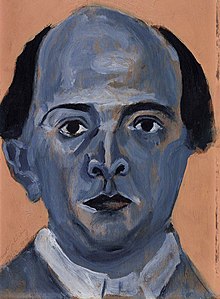
Back Pierrot Lunaire (Schönberg) Catalan Pierrot Lunaire German Pierrot Lunaire Spanish Pierrot lunaire French פיירו הסהרורי HE Pierrot Lunaire (Schönberg) Italian 月に憑かれたピエロ Japanese მთვარის პიერო Georgian 달에 홀린 피에로 Korean Pierrot Lunaire (Schönberg) Dutch
| Pierrot lunaire | |
|---|---|
| Melodrama by Arnold Schoenberg | |
 Self-portrait by Schoenberg, 1910 | |
| Full title | Dreimal sieben Gedichte aus Albert Girauds "Pierrot lunaire" |
| Opus | 21 |
| Style | Free atonality |
| Text | Albert Giraud's Pierrot lunaire |
| Language | German |
| Composed | 1912 |
| Duration | About 35 to 40 minutes |
| Movements | 21 |
| Scoring | Pierrot ensemble plus reciter |
| Premiere | |
| Date | 16 October 1912 |
| Location | Berlin Choralion-Saal |
| Conductor | Arnold Schoenberg |
| Performers | Albertine Zehme (voice) Hans W. de Vries (flute) Karl Essberger (clarinet) Jakob Malinjak (violin) Hans Kindler (cello) Eduard Steuermann (piano) |
Dreimal sieben Gedichte aus Albert Girauds "Pierrot lunaire" ("Three times Seven Poems from Albert Giraud's 'Pierrot lunaire'"), commonly known simply as Pierrot lunaire, Op. 21 ("Moonstruck Pierrot" or "Pierrot in the Moonlight"), is a melodrama by Arnold Schoenberg. It is a setting of 21 selected poems from Albert Giraud's cycle of the same name as translated into German by Otto Erich Hartleben. The work is written for reciter (voice-type unspecified in the score, but traditionally performed by a soprano) who delivers the poems in the Sprechstimme style accompanied by a small instrumental ensemble. Schoenberg had previously used a combination of spoken text with instrumental accompaniment, called "melodrama", in the summer-wind narrative of the Gurre-Lieder,[1] which was a fashionable musical style popular at the end of the nineteenth century.[2] Though the music is atonal, it does not employ Schoenberg's twelve-tone technique, which he did not use until 1921.
Pierrot lunaire is among Schoenberg's most celebrated and frequently performed works. Its instrumentation – flute, clarinet, violin, cello, and piano with standard doublings and in this case with the addition of a vocalist – is an important ensemble in 20th- and 21st-century classical music and is referred to as a Pierrot ensemble.
The piece was premiered at the Berlin Choralion-Saal on October 16, 1912, with Albertine Zehme as the vocalist. A typical performance lasts about 35 to 40 minutes. The American premiere took place at the Klaw Theatre, on Broadway, New York, on 4 February 1923 as part of a series of concerts organised by the International Composers' Guild.[3]
- ^ Neighbour 2001.
- ^ Dunsby 1992, 2.
- ^ Lott, R. Allen (1983). "'New Music for New Ears': The International Composers' Guild". Journal of the American Musicological Society. 36 (2): 266–286. doi:10.2307/831066. ISSN 0003-0139. JSTOR 831066.